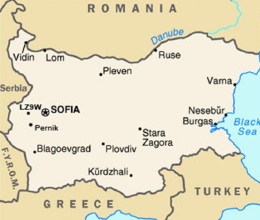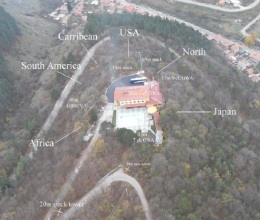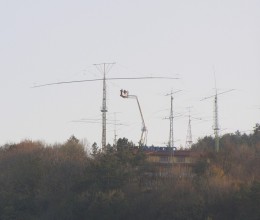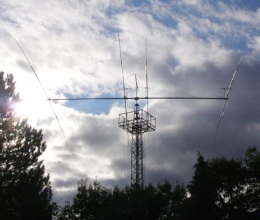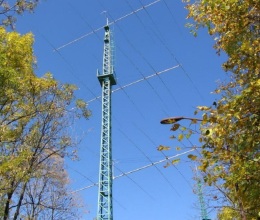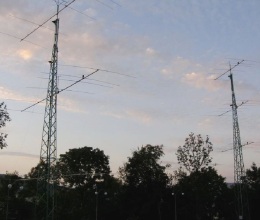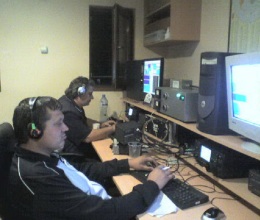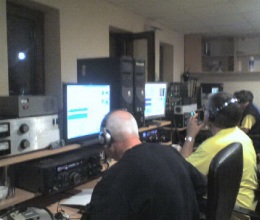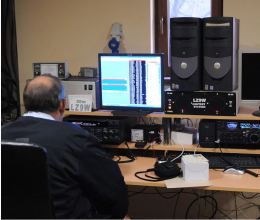Southern California Contest Club
ARRL Sweepstakes CW: November 1-3 <ARRL Sweepstakes SSB: November 15-17 NA Sprint SSB: November 23
ARRL Sweepstakes CW: November 1-3 <ARRL Sweepstakes SSB: November 15-17 NA Sprint SSB: November 23
Past Feature Stories (Newest to Oldest)
The E7DX Contest Station - Braco Memic E77DX
April 2014
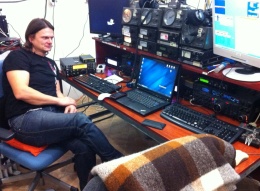 E7DX is the contest call of Braco E77DX and gang. It is used mainly from the E77DX QTH in the northwest part of Bosnia in the town Prijedor (Grid JN84IX).
It is just on the SW border of the city in the fields at 129m ASL.
E7DX is the contest call of Braco E77DX and gang. It is used mainly from the E77DX QTH in the northwest part of Bosnia in the town Prijedor (Grid JN84IX).
It is just on the SW border of the city in the fields at 129m ASL.The station is situated in a small house about 25m² (shack only) and there is a container with a small kitchen and a place for sleeping. It is five minutes from the city by car and has good infrastructure (electrical power and water), safety
The shack has four operating positions, fully automated and optimized for SOAB/MS/M2 and it is capable of remote controlled operation.
Since 2007 over 450,000 QSOs have been logged from here counting all call signs. more
We use 3 x Microham Microkeyer II and 1 x Microham MK2R+.
Station control uses 4 x Microham Station Master Deluxe units controlling all switching devices (Antennas, Stacks, 4SQ, Beverages) and rotators from any operating position.
The software employed is Wintest, DX-log by 9A5K and FT-2000RC by DF3CB for remote operation.
We use an antenna switching matrix for 4 Radios (3 ports on same time) to 18 Antennas (3 groups for each Band). This allows 4 radios to choose 3 different antennas (groups=stack) per band.
We have a Beverage box which switches 4 radios between 8 antennas. RX comutator 3 RX + beverage + inband to 3 radios. 3 x ACOM 2S1 Switch.
Radios are: FT2000D, 2xFT2000, FT1000 MkV Field, 2xPerseus. Amplifiers are 5 x R-140 (LV6) (10 tuning memories 160-10m), 2 x R-140 (LV6) (10 tuning memories 20-6m mainly used only on 6m), 1 x OM-3500A.
Our team consists of E70R Ranko, E70T Vlado, E71DX Sanjin, E73CQ Fudo, E74AW Dado, E76C Zoka, E77E Robi, E77W Rade, E77WM Zvone Plus WRTC 2014 competitors: 9A1TT Rich, 9A5K Chris, E77DX Braco.
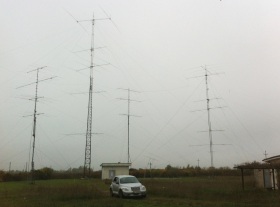 We are active in all major SSB/CW contests and sometimes RTTY. We have many European and some Worldwide trophies. We are the holder of some European records!
We are active in all major SSB/CW contests and sometimes RTTY. We have many European and some Worldwide trophies. We are the holder of some European records!Our best results are achieved in CQ WPX and CQ 160 in the SOAB and MS categories.
You can also hear E7DX on 2m, usually in the July and September contests from one of the locals hills. We are using there K3 + TRCV – Javornik II with a homebrew amplifier using a GS-35B and various antennas systems.
Since 2007 the station has been constantly improving and this will continue. We QSL with classic paper cards via bureau or direct and we also use LoTW.
More pictures: 1 2 3 4 73 Braco E77DX close
The HG7T Story - Tibi Nemeth, HA7TM
April 2014
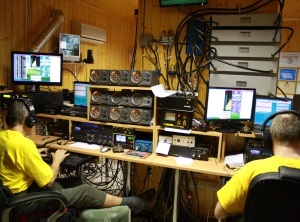 The HG7T station is actually located in the HA0 district, but fortunately the Hungarian rules are similar to those of the US, and I could keep the call, when I
moved my contest location to HA0.
The HG7T station is actually located in the HA0 district, but fortunately the Hungarian rules are similar to those of the US, and I could keep the call, when I
moved my contest location to HA0.I bought the property in 2009 from another ham, who already had a 100 foot tall tower with a TH7DX and an A3WS atop, plus wire antennas for low bands, and several long Beverages for low-band reception. The station was mostly DX-oriented rather than built for contesting.
I stated with erecting 4 new self-supporting 115 feet tall towers, for 40, 20, 15 and 10 meter antennas. The original 40 m antenna was a 3 element Opti-Beam, which I had to replace by a 4 element KLM when we got access to the "high" portion of 40. The Opti-Beam is still there, waiting to be installed for a second direction. For the three high band I chose ZX Yagi antennas, 2x6 for 20, 2x7 for 15 and 10. more
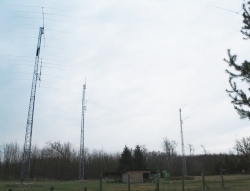 All seven antennas are mounted on small trolleys, which can be lowered if one of the antennas need maintenance. The upper antennas can be rotated 450 degrees, the
lower ones only about 70 degrees (between JA and USA). All rotors are Yaesu GX2880DXC's.
All seven antennas are mounted on small trolleys, which can be lowered if one of the antennas need maintenance. The upper antennas can be rotated 450 degrees, the
lower ones only about 70 degrees (between JA and USA). All rotors are Yaesu GX2880DXC's.This setup was fine for the first year or so, but then I realized I needed something better for 80, than a Delta loop. I decided to erect a 150 foot self-supporting steel tower, and a 3 element Opti-Beam antenna has been installed for 80 meters. The monster required a bigger rotator, so an Italian-made GE1500/T was installed.
This is most probably the biggest amateur radio antenna in Hungary, and there are not many bigger ones in Europe either... The only "single element" band remains 160 meters, where the tuned tower vertical is not a winner, so sooner or later a better TX antenna will be built.
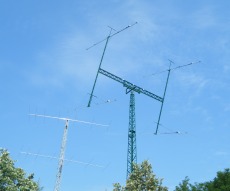 When I decided to try Multi-Two, I bought FTDX5000 transceivers, and OMPower amplifiers for the two main operating positions, and the secondary radios are an
FT2000 and an FT1000MP.
When I decided to try Multi-Two, I bought FTDX5000 transceivers, and OMPower amplifiers for the two main operating positions, and the secondary radios are an
FT2000 and an FT1000MP.Each pair of radios have Acom lockout devices. The antennas are controlled by a SixPack and StackMatches from WX0B.
We take part in almost every contest, which means I drive on most Fridays from Érd (near Budapest) to Debrecen, about 150 miles one way. Then Friday afternoon we have to fix Beverages, check software and all equipment, and have contesting fun over the weekend
So far we have never had serious technical issues, except that because of the location (a remote "farm" in the middle of a large forest), in stormy weather we lost electricity once or twice.
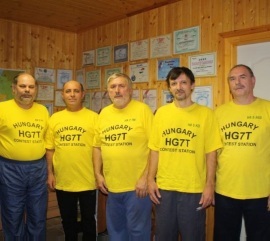 Operators include people from my former HG7T core team (HA5AGS, HA5WA, HA5MY, HG5DX), but I also found good people in Eastern Hungary (HA8IB, HA9PP, HA0DU).
Occasionally other contesters join us, like HA5PP, HA0NAR, HA8JV, UZ5DX).
Operators include people from my former HG7T core team (HA5AGS, HA5WA, HA5MY, HG5DX), but I also found good people in Eastern Hungary (HA8IB, HA9PP, HA0DU).
Occasionally other contesters join us, like HA5PP, HA0NAR, HA8JV, UZ5DX).The very continental location (grid locator KN07vn) is not the greatest one for winning. The rule of thumb in European contesting is "the one who works the most Americans, is the winner". There is normally no big difference between the number of multipliers worked by us and the stations in Western Europe.
We even have an advantage of working Asia easier. But this does not compare with the fact that some of our competition are 25% closer to the US, and to the Caribbean, which provides a little advantage for them to catch more multipliers on low bands. This is a given, and it is especially true, when 10 and 15 meters are wide open. We will see when these bands are much worse (that is, no big runs of US on 10), then our larger antennas, and capability of TXing in at least two directions should bring us closer to the top.
The installation of the second 40 m Yagi, and the incorporation of a tribander towards Africa to the system, should also help.
More pictures: 1 2 3 4 73 and CU in the next Contest! Tibi HA7TM/HG7T close
The CW5W Story - Jorge Diez CX6VM
June 2014
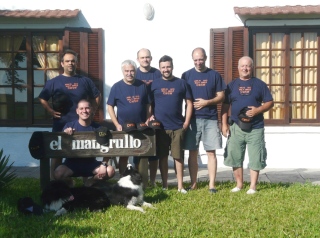 How did I become a ham radio operator? Between the 50's and 60's, my mother started with this hobby, without knowing what it was. My parents had a farm, where
they lived and the only way to communicate was with an old homebrew radio for 160m. The farm was 30 km. away from the city of Melo, and the
road in those years was a dirt track. In the middle it had a wood ridge; when it rained it got covered by the water, so you can understand how useful the
radio was.
How did I become a ham radio operator? Between the 50's and 60's, my mother started with this hobby, without knowing what it was. My parents had a farm, where
they lived and the only way to communicate was with an old homebrew radio for 160m. The farm was 30 km. away from the city of Melo, and the
road in those years was a dirt track. In the middle it had a wood ridge; when it rained it got covered by the water, so you can understand how useful the
radio was.My mother knew some ham's in Uruguay and later they introduced her to "real" ham radio with good equipment that covered all HF bands.
I was born in June 1968. In 1985 I got a license to operate as a second operator of my mother Sonnia, CX4VA. I spent most of my time on 40 talking with CX, LU and PY and occasionally with other South American hams. I got some friends, but I needed more. I didn't like very much long chats; I liked to contact DX stations and receive their QSL cards along with stamps, photos etc. more
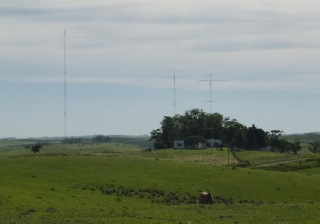 I spent many hours of the night on 40m DXing but I had to get up early to go to school so my mother came to my room where the radio was, switched it off, and
sent me to sleep.
I spent many hours of the night on 40m DXing but I had to get up early to go to school so my mother came to my room where the radio was, switched it off, and
sent me to sleep.Sometimes I heard rare ones on 40, but I couldn't work them with my dipole and 100 watts. What could I do to improve my DX activity and also make sure my mother didn't hear me yelling to DX stations? I had to learn morse code!
In April 1987 I got my own license, CX6BM and I wanted to get the DXCC as soon as possible.
In 1993 I got my new and actual callsign CX6VM and also a new antenna, a 3 elements tribander. The 1993 CQWWCW contest was close, and I was very enthusiastic with my new antenna, so I tried to develop a serious activity on it.
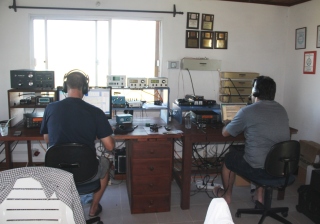 I've been studying in Montevideo for six years. Montevideo is the Capital city of Uruguay but all my family lives in Melo City, that is 400 km. from Montevideo,
and 60 km. from the Brazilian border. So I'm not very active, only for contests. I get on a 5 hour bus trip to arrive one hour before the contest starts and three
hours after it finishes (Monday 0300 UTC) I return to Montevideo, to get ready for college and work.
I've been studying in Montevideo for six years. Montevideo is the Capital city of Uruguay but all my family lives in Melo City, that is 400 km. from Montevideo,
and 60 km. from the Brazilian border. So I'm not very active, only for contests. I get on a 5 hour bus trip to arrive one hour before the contest starts and three
hours after it finishes (Monday 0300 UTC) I return to Montevideo, to get ready for college and work.In October 1997 I was invited to operate CQWW SSB in Paraguay at ZP0R, were I met Tom ZP5AZL and Dale N3BNA, we became great friends. After that we traveled together to do contests in different places, like TI5N, 9Y4W, PJ4K.
In 2007 I moved to my family city, Melo, in the NE part of Uruguay. I raised a tower in my mothers farm and since then the station continues to grow. Actually I have 3 towers and monobanders, and we enter in the most important contests.
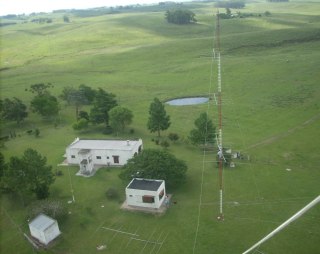 In 2008 I started using the special contest callsign CW5W. I think it has become well known and has given the multiplier CX to many contesters, with high demand
especially on the low bands.
In 2008 I started using the special contest callsign CW5W. I think it has become well known and has given the multiplier CX to many contesters, with high demand
especially on the low bands.We usually meet with other CX friends as well as LU and PY to do Multi Operator entries in the most important contests from CW5W, where we spend a great time doing what we like! This is the best of our hobby!
Actually CW5W is ready for SOSB, SOAB, SO2R, MS and M2, with two operating positions using Elecraft K3 radios, amplifiers and Yagi monobanders for 10 to 40m and wire antennas for 80 and 160m.
I got married to a wonderful girl, Carolina. We have one 4 year old son called Francisco and another one, Gonzalo that is 1 year old. Carolina's support is wonderful, she understands very well our passion of ham radio, and she likes very much to receive people at the station. More pictures: 1
Best wishes for all and hope to see you in future contests. 73, Jorge CX6VM/CW5W close
The Rio DX Group PR1T - Felipe Ceglia PY1NB
March 2014
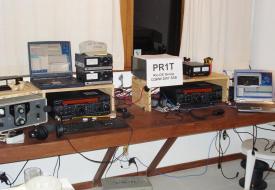 The Rio DX Group’s contest station project started in CQWW SSB 2006, the operators where only PY1NB and PY1ZV, using the callsign ZW1TT.
The Rio DX Group’s contest station project started in CQWW SSB 2006, the operators where only PY1NB and PY1ZV, using the callsign ZW1TT.In this operation’s debriefing we decided to go on with the project, change the callsign to PR1T and evolve the modest “wires and tribander” setup to something a tad larger.
The project target was to have a minimally competitive contest station and a place to let new operators get their feet wet at HF contesting.
On CQWW SSB 2007 we made our debut. Still with a very modest setup, only one amplifier, manual antenna switching but now with a short 2 element 40m beam, We were still rookie operators, we joined the contest mainly to practice and learn. more
Since then we have been constantly evolving the station and operator team. Today we have 12 operators involved with the station operation and maintenance:
PY1NB – Felipe (Host), PY1ZV – Fábio, PY1NX – Soni, PY1FI – Anderson, PY4TJ – Carlos, PY1ON – Lineu, PY1GQ – Chicão, PY1MK – Marcos, PU1MKZ – Fernando, PY1CPF – André, PY1EW – Fábio, PY1TR – Felipe
We have four operating positions, we usually have a pair of K3 rigs, TS590 and FT200 plus two legal power (PY legal power) amplifiers.
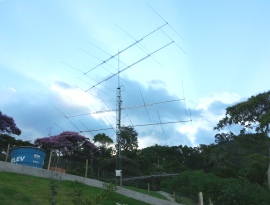 We have developed and home brewed our own microprocessor based interlocking system, monoband stackmatches using LC circuits and a wireless remote control based on
Zigbee technology that controls rotators, stackmatches and any other relay we possibly need to control.
We have developed and home brewed our own microprocessor based interlocking system, monoband stackmatches using LC circuits and a wireless remote control based on
Zigbee technology that controls rotators, stackmatches and any other relay we possibly need to control.We have replaced most of the gadgetry and clutter of having many control boxes around by Android tablets with the controls on screen!
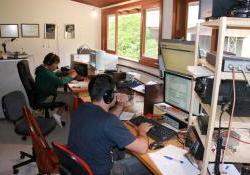 In the last five years we have been top five on Worked All Europe DX Contests, as PR1T or using some of the operators callsign and we are usually active in
the major contests: ARRL DX, CQWW and CQWPX.
In the last five years we have been top five on Worked All Europe DX Contests, as PR1T or using some of the operators callsign and we are usually active in
the major contests: ARRL DX, CQWW and CQWPX.Our objectives for 2014 are to keep the PR1T call on the air in all possible contests, keep developing our home made solutions, improve low bands RX and replace our 20m antenna setup.
73 de PR1T team! CU IN TEST! close
The Torrent Contest Club ED5T - Duncan Lindsay EA5ON
March 2014
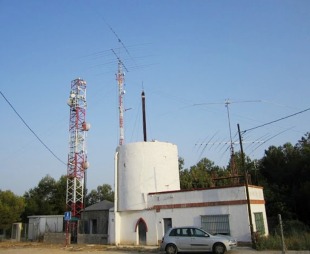 The Torrent Contest Club is a group of 7 active operators who have set up a modest contest station on the premises of the local chapter of the URE
(Spanish equivalent of the ARRL) in Torrent, near the city of Valencia, on Spain’s east coast. We normally use ED5T as our contest call
The Torrent Contest Club is a group of 7 active operators who have set up a modest contest station on the premises of the local chapter of the URE
(Spanish equivalent of the ARRL) in Torrent, near the city of Valencia, on Spain’s east coast. We normally use ED5T as our contest callFirst came the QTH. URE Torrent (URET) originally held its meetings and social activities in an apartment belonging to the local council. However, when the local police vacated their vantage point at the top of the hill that dominates the town, URET president EA5CVT was quick to point out that relocating the club to that QTH would be a win-win situation to all involved.
At that time there were two serious contesters in URET; Victor EA5KV and Dave EC5KXA. These two gentlemen set up first of all a small TH3 JR tribander to test the waters. First results looked good so they then put up an Explorer 14 on the 70’ free standing tower the police had left us. This looked better! Vic and Dave did a couple of monoband entries in different contests with very positive results. more
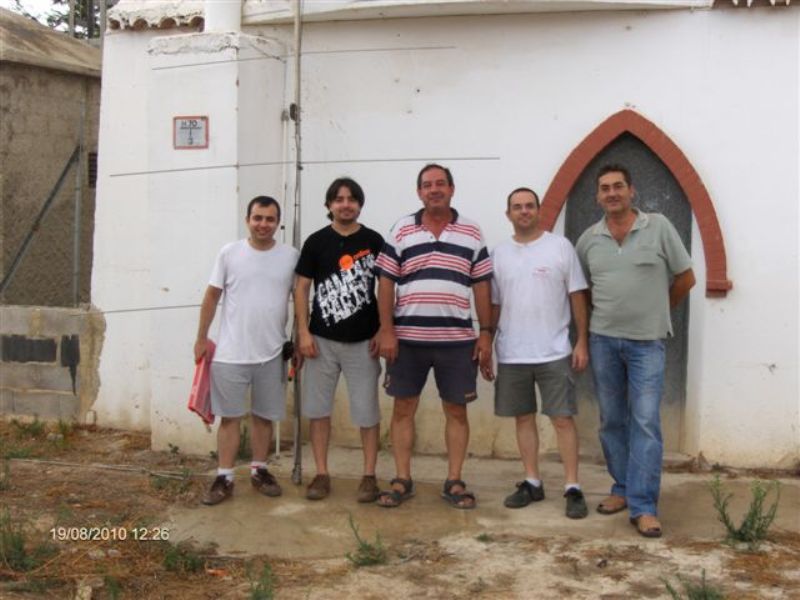 Then came the ops. Vic and Dave knew that there were some contesters in the area who didn’t have good home stations and operated as “hired guns” at different
multi-op stations. Duncan EA5ON and Jose EA5GS were thus invited to join.
Then came the ops. Vic and Dave knew that there were some contesters in the area who didn’t have good home stations and operated as “hired guns” at different
multi-op stations. Duncan EA5ON and Jose EA5GS were thus invited to join.Also within URET, there were a couple of young technology students who looked like they might enjoy contesting. So Elías EB5KT and Paco EB5TC were invited join.
We had a quick look to see if there were any “sleeping” contest ops in the club, which is when we discovered Juan Carlos EA5UF.
Finally, the pillar of our tech team, Juan EA5GIE, expressed an interest in joining.
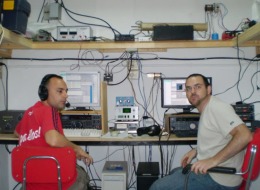 Once constituted, we got to work on the station. Our first contests were held in the clubhouse using the Explorer and wire dipoles.
Once constituted, we got to work on the station. Our first contests were held in the clubhouse using the Explorer and wire dipoles.We then moved the station into a purpose built two position bunker, designed for Multi-Single contesting (or two single-ops).
Over the past 5 years we have slowly added bits and pieces to the shack. We share it with other URET members so normally, one position uses the clubs TS850S, and the other has the contest club’s FT1000MKV Field and an old Ameritron AL1200.
When doing a major contest, we will swap out the club radio for an FT2000 and put in one or two Acom amps.
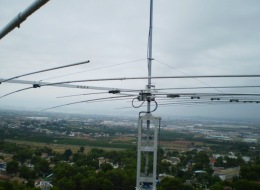 Contesting in Spain has undergone a profound change in the last few years. A number of young contesters like EC1KR (owner of ED1R) and EC2DX have put in serious
work at their stations, putting in some top class scores.
Contesting in Spain has undergone a profound change in the last few years. A number of young contesters like EC1KR (owner of ED1R) and EC2DX have put in serious
work at their stations, putting in some top class scores.Established contesters have risen and taken the bait, and there is now a healthy competitive atmosphere with a lot of contesters having a lot of fun, amongst them, the ED5T contest group, aka Torrent Contest Club.
We look forward to continuing to work many SoCal contesters in the upcoming contests!
73 de Duncan EA5ON
On behalf of the Torrent Contest Club (ED5T) close
The North Pole Contest Group - KL7RA
March 2014
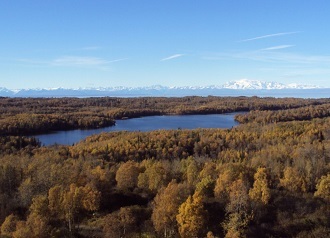 Hello SCCC. The following is a description, highlights, plans and progress of the multi op station KL7RA located near the small village of Nikiski on the Kenai
peninsula, south central Alaska.
Hello SCCC. The following is a description, highlights, plans and progress of the multi op station KL7RA located near the small village of Nikiski on the Kenai
peninsula, south central Alaska.Hopefully all SCCC members have worked KL7RA and the North Pole Contest Group in contests for the last 40 + years and we expect to work all of you in contests for many more.
The station was originally located in Fairbanks in four different locations from the 1970’s to 2004 but all were above 64 degrees north latitude directly under the aurora. We also suffered Arctic absorption and the bands would go silent for days on end after a CME event. We seldom had propagation on the 80 meter band due to winter E’s. Nevertheless we operated from an excellent location on a very high hill working stations others in the area could not hear so we stayed multi-op and often entered ten or more contests a year. more
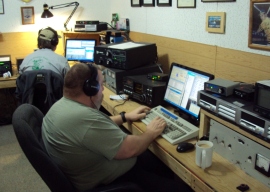 The last interior Alaska QTH about 100 miles south of the Arctic circle was near the community of Two Rivers, about 17 miles east of Fairbanks. We operated there
from 1986 to 2004. The station was located in a building beside my home. For antennas we had 21 Yagis in stacks on seven towers from 190 feet down to 100 feet.
The last interior Alaska QTH about 100 miles south of the Arctic circle was near the community of Two Rivers, about 17 miles east of Fairbanks. We operated there
from 1986 to 2004. The station was located in a building beside my home. For antennas we had 21 Yagis in stacks on seven towers from 190 feet down to 100 feet.I retired Dec 2003 and had spent most of that year taking down the station. After working with some hams on the Kenai peninsula south of Fairbanks by 400 miles it was clear that was the place to retire and build a station that would be somewhat competitive for both USA domestic and the WW.
Even with a lot of property for sale it still took a year to find the right location. I was looking for a steep hill with the ocean to the north towards Europe with few neighbors.
Just the right hill did finally show up on the market but it was raw property which required a very long road, underground utilities, septic, well and a home to be built.
It took five 26 foot long truck loads to get the hardware from Fairbanks down to the new Kenai location.
Today the station is active on the Kenai using eight towers. Most of the towers are alongside the edge of a steep drop off going north to Europe and west to Asia over saltwater and a very steep cliff east to USA over lakes.
The first antenna was a temporary 80 meter inverted vee up all of 40 feet that worked more Europe that evening than the past 33 years in Fairbanks.
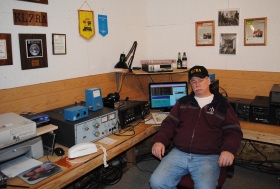 The tower and Yagi stacking heights were done by Dean, N6BV who spent the afternoon selecting the best sites of the 15 or so I had marked out.
The tower and Yagi stacking heights were done by Dean, N6BV who spent the afternoon selecting the best sites of the 15 or so I had marked out.After the site selection N6TR, K5KA, AL7IF, N5RZ and K6AW came up to help install the towers. They go up pretty fast with a big crew once I had the right guy wires sorted out. I installed the rest myself but it took four times as long for each tower. Another time sink was building the house and all the “stuff” my wife wanted to add etc.
I lost two years of contesting moving from Fairbanks down to south central Alaska but it was worth it by a factor of ten. Kenai propagation is much better than what we experienced in the interior of Alaska and the antennas worked exactly as the N6BV terrain analysis predicted they would.
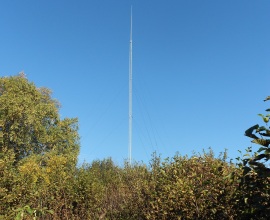 Today we host about 20 contests a year. Most are multi-op and we have been thankful that a lot of my friends over the years make it up to Alaska to operate.
The regular crew this past few years has been Wigi, AL7IF who has been contesting with us since the late 80’s (He set the North America record for the All Asia
phone last year). Kris, AL2F and Jeff, KL2HD from Homer come up every contest.
Today we host about 20 contests a year. Most are multi-op and we have been thankful that a lot of my friends over the years make it up to Alaska to operate.
The regular crew this past few years has been Wigi, AL7IF who has been contesting with us since the late 80’s (He set the North America record for the All Asia
phone last year). Kris, AL2F and Jeff, KL2HD from Homer come up every contest.Larry, N1TX from Fairbanks and Steve, KL7SB from Anchorage are here often. Carl, WL7BDO from Nenana comes down for the big ones and Dave, KA1NCN does not miss the ARRL DX or the WW. Often N6TR, Tree comes up and he holds the Alaska SS records for both phone and CW.
K6AW, Steve and Trey N5KO have made multiple trips up. The station has also hosted the Bavarian Contest Club with a large group of operators from Germany and many other visitors and guest ops such as K1EA, N0AX, K1KI K5ZO HA1AG and so on.
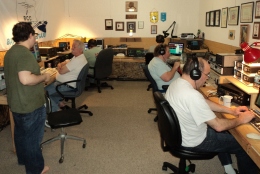 Current plans are to finish the addition which will add 32 feet of bench space so we can add the final two positions for a total of nine and add the ninth tower for
15 meters West. The Kenai QTH has been excellent for radio and all what I hoped for when I retired.
Current plans are to finish the addition which will add 32 feet of bench space so we can add the final two positions for a total of nine and add the ninth tower for
15 meters West. The Kenai QTH has been excellent for radio and all what I hoped for when I retired.This is not without a tax however. Major storms have caused a lot of antenna damage these past eight years and we are in a constant state of antenna repair and road maintenance. The moose come from miles around to be able to stomp the Beverage wires into the ground. Work in the summer requires constant bear surveillance as they wait their opportunity to get a free lunch of “Beverage repair man” served on Devils Club, open face.
73 Rich KL7RA North Pole Contest Group, Nikiski, Alaska. 2014 Jan. close
The ES5TV Contest Station - Tonno Vahk ES5TV
March 2014
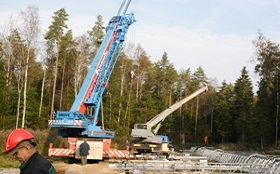 I was born in a small town of Jogeva in central Estonia and brought into ham radio by my late father ES5JH at the age of 13 in 1991. I got my own license in 1992
as ES5RTV and upgraded to 'A' category a year later as ES5TV.
I was born in a small town of Jogeva in central Estonia and brought into ham radio by my late father ES5JH at the age of 13 in 1991. I got my own license in 1992
as ES5RTV and upgraded to 'A' category a year later as ES5TV.I started out with a home-made UW3DI type of radio (around 50 watts output) and a horizontal delta loop between two 5-storeyed houses in my hometown.
In the second half of the nineties I started my contesting career, taking part in operations from the ES5Q/ES6Q station in the hills of south-eastern Estonia. At the same time I started to build my station in the countryside close to Jogeva. By now the antenna farm has grown to include five large rotating towers as follows: more
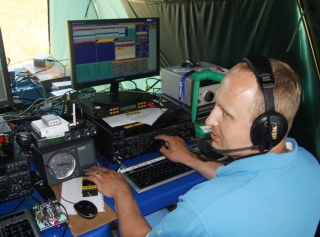 45 meters high tower with 4 x JP2000 tribanders (10 elements each), 3 over 3 full size yagis for 40 meters, rotating dipole for 80 meters, wire vertical for
160 meters and some WARC and UHF antennas.
45 meters high tower with 4 x JP2000 tribanders (10 elements each), 3 over 3 full size yagis for 40 meters, rotating dipole for 80 meters, wire vertical for
160 meters and some WARC and UHF antennas.35 meters high tower with 3 x JP2000 tribanders.
45 meters high tower with 6 over 6 on 10 meters, 5 over 5 on 15 meters, 5 over 5 on 20 meters, 3 over 3 shortened on 40 meters and 3 element shortened 80 meter yagi. All those are Optibeam antennas.
45 meter “multiplier” tower about 600 meters from the main station in the forest carrying Optibeam 17-4 fourbander, 80 meter Inverted V and 160 meter wire 4 Square.
The newest, 70 meter high tower with 8 x 5 element collinear stack on 15 meters.
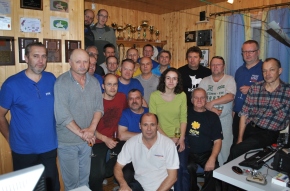 For the low bands I have full size 4 squares on 80 and 160 meters and some more wire antennas.
For the low bands I have full size 4 squares on 80 and 160 meters and some more wire antennas.Several great single op and multi op results have been made from there during the last 10 years. Multi op results mostly under ES9C call sign.
I have also had great opportunities of guest operating from the marvelous stations of Pekka, EA8AH; Bernie, ZS4TX; Arcala, OH8X and Ranko, 4O3A. Repeatedly winning SOAB HP category in EU would have been very difficult from Estonia (although I was lucky to manage it in 2005) but the 4O3A station enabled me to do it.
73 Tonno ES5TV http://pontu.eenet.ee/es5tv/ close
PJ2T: The Caribbean Contesting Consortium - W0CG/PJ2DX & N0YY
March 2014
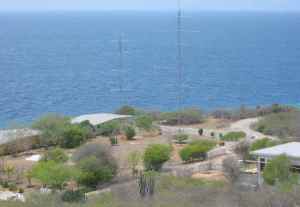 Curacao, home of PJ2T, has a rich radio sport history. Situated about 40 miles north of the coast of Venezuela, the island location has hosted many winning
contest efforts over the years.
Curacao, home of PJ2T, has a rich radio sport history. Situated about 40 miles north of the coast of Venezuela, the island location has hosted many winning
contest efforts over the years.The property is owned by Geoff, W0CG and the radio contest station is overseen by the Caribbean Contesting Consortium (CCC). The CCC is a contest club dedicated to fun, international friendship, and advancement of the contesting art through superior operating technique and maximum application of technology.
Starting in the early 70s, John Thompson – W1BIH, assembled teams of operators that represented the “who’s who” of DX contesting. The magical propagation from that location resulted in a many world high scores for contests year after year. The beginnings were humble with a simple tribander and wire antennas. more
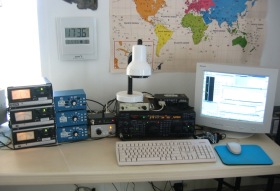 In the year 2000, Geoff and the Caribbean Contesting Consortium acquired the property in hopes of continuing the long contest history from that location. The station
evolved to the superstation status it enjoys today. The location speaks for itself with its number of wins and high placements in the premier annual contests.
In the year 2000, Geoff and the Caribbean Contesting Consortium acquired the property in hopes of continuing the long contest history from that location. The station
evolved to the superstation status it enjoys today. The location speaks for itself with its number of wins and high placements in the premier annual contests.The PJ2T station is up and running as a world-class contest station. Antennas for all bands are mounted on three towers – 100 foot European tower, the 80 foot US/JA tower and the original 65 foot tower.
Antennas for 160-10, the WARC bands, and 6M are available for contesting or for holiday style operating. In addition we have several receive antennas to complement our transmitting antennas.
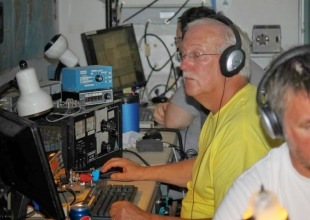 Inside the station are four operating positions. Each of the positions has access to all of the antennas. The station was designed for multi-operator contesting
as well as a rental property for ham vacations. Each station has computer control of radios as well as hosted logging software. The station can be configured
for SO2R operations or for full M/M operations.
Inside the station are four operating positions. Each of the positions has access to all of the antennas. The station was designed for multi-operator contesting
as well as a rental property for ham vacations. Each station has computer control of radios as well as hosted logging software. The station can be configured
for SO2R operations or for full M/M operations.Today, club members and visitors from all over the globe have been part of teams that continue to grow the PJ2T legacy. We enjoy participating with WRTC team members and everyday hams. The station is active for most major contests.
PJ2T is arguably the most logged callsign with nearly one million QSOs in the contesting logs. Truly it is “Contesting from Paradise”.
For more information access the PJ2T website at www.pj2t.org close
The Papa-3 Contest Club ED1R - Jesus Marquez EC1KR
February 2014
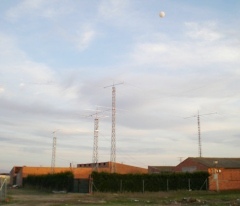 ED1R was founded in the summer of 2010. It is located in central Spain, in a small village of around 500 people in the province of Avila, about 100km from Madrid,
167km from the Portuguese border and 311km from the Atlantic ocean, towards North America. The village is around 1100m (about 3600ft) asl, on flat land
and good takeoff towards North America.
ED1R was founded in the summer of 2010. It is located in central Spain, in a small village of around 500 people in the province of Avila, about 100km from Madrid,
167km from the Portuguese border and 311km from the Atlantic ocean, towards North America. The village is around 1100m (about 3600ft) asl, on flat land
and good takeoff towards North America.The location is a small plot of land belonging to EC1KR’s father, in amongst a vegetable garden. Space is limited, around 300m². We started by planning 4 towers, and after doing the welding work for installing rotators and masts, installed them (one 23m high tower, one 16m high, and two 12m high). We then installed our first antennas, a 2 element M² yagi for 40m, 4 element monoband DXBEAMS for 20 and 15, and a 5 element DXBEAM for 10.
We also put in a lot of work to the shack. Currently we have a spacious four position operating area, sleeping space for 5, a shower and toilet, and a small work area. more
From 2011 to 2014 we carried out extensive antenna work, we now have a fifth tower and we have made significant improvements thanks to the work done by our chief engineers DH1TW and EA4TX.
We have some interesting hardware, such as the 4O3A high power bandpass filters.
We have a beverage switchbox which allows us to route the RX antenna signals to all of the rigs in the shack
We use a 4O3A high power triplexor which allows us to use the Optibeam OB11-3 tribander on 3 bands at the same time, effectively making it into 3 monobanders.
We have stack matches based on the SJ2W boards and use the EA4TX ARS control boxes with DH1TW software to control all the TX/RX antennas through wintest, our chosen contest software. All rotators are also controlled using an EA4TX designed ARS rotor control which allows mouse-controlled operation.
Finally, we have another Spanish-made accessory, which are adaptable interlocks for use in either Multi-single or Multi-2. These are made by radio-applications.com
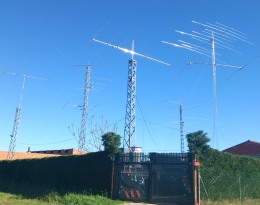 The group of operators is comprised of people of different levels of skill and experience. We operate international contests in SSB, CW and RTTY. Our station is
optimized for either MS or M2 but we have done a few MM contests too. We are especially active in CQWW, CQWPX, RUSSIAN DX, and His Majesty King of Spain.
The group of operators is comprised of people of different levels of skill and experience. We operate international contests in SSB, CW and RTTY. Our station is
optimized for either MS or M2 but we have done a few MM contests too. We are especially active in CQWW, CQWPX, RUSSIAN DX, and His Majesty King of Spain.The operators are: DH1TW, EA1ASC, EA1FAQ, EA1AR, EA1CJ, EC1KR, EB3CW, EC4DX, EA4TD, EA4TX, EA4SV, EA4ZK, EA4AOC, EA4GBV and EC4TA.
We have been happy to receive visitors from many EA friends, some of whom contest with us, also operators from Italy, Germany, Russia, Ukraine, and Portugal.
We confirm all QSLs received via the bureau and direct via EC1KR although our preferred method is via LOTW and all QSOs are uploaded as soon as a contest is over.
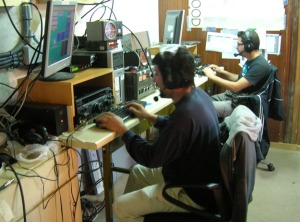 Over the past 3 years we have managed to obtain notable improvements in our results due to hard work and optimization in the station, We are not able to install
larger towers and in Spain large installations are not looked upon kindly so we have to compete with what we have, notwithstanding this we have managed to get
into the top 5 or top 10 in all the international contests and also win a few too.
Over the past 3 years we have managed to obtain notable improvements in our results due to hard work and optimization in the station, We are not able to install
larger towers and in Spain large installations are not looked upon kindly so we have to compete with what we have, notwithstanding this we have managed to get
into the top 5 or top 10 in all the international contests and also win a few too. A point to note is the participation of EA stations in international contests, we see that from one year to the next there are more stations and better prepared. This improvement is noticeable over the last 5 years and finally we feel we are able to compete with some of the central European “big guns”.
We look forward to working you on the air!
73 and happy contesting
EC1KR Jesus (ED1R) www.ed1r.com
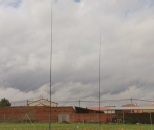 |
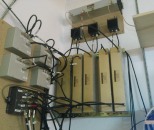 |
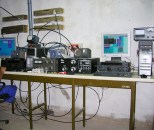 |
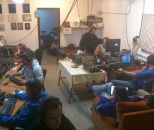 |
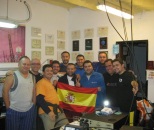 |
9A1A: The big Signal from a Small Country (Croatia) - Petar Milicic 9A6A
February 2014
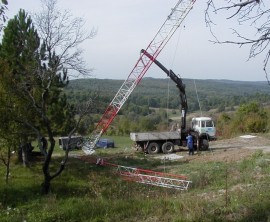 Those who have been active during the DX contests of the past few years are familiar with the big signal emanating from 9A1A near Zagreb, Croatia. The station is owned
by the Croatian DX Club, whose members activate it for all major contests. Petar, 9A6A, has been kind enough to provide information about the club and the station
Those who have been active during the DX contests of the past few years are familiar with the big signal emanating from 9A1A near Zagreb, Croatia. The station is owned
by the Croatian DX Club, whose members activate it for all major contests. Petar, 9A6A, has been kind enough to provide information about the club and the stationThe Croatian DX Club consists of a few of the best radio amateurs in Zagreb and Croatia. Although first heard as 9A1A in the CQ WW DX Contest (SSB) in 1992, the members had been active before the war in Croatia as YT2R and YT2E.
The club began building the tower and antenna system more than 25 years ago. We had seen that if you put too many kilowatts into a bad antenna, you only make big QRM and the results won't be good so we decided to build a good antenna system. We felt we could win in all contests if we could hear the many thousands of US and JA stations that use less than 100 watts and a dipole antenna. more
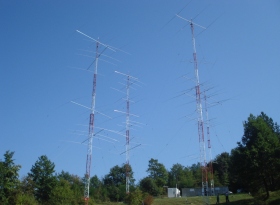 The main members of our Club are Niksa, 9A5W, Emil, 9A9A, Zeljko, 9A2DQ; Braco, 9A7R and me, Petar, 9A6A. We have another 10 to 15 members to help us in contests and
logistics. The club is in a building near Lake Jarun in the western part of Zagreb.
The main members of our Club are Niksa, 9A5W, Emil, 9A9A, Zeljko, 9A2DQ; Braco, 9A7R and me, Petar, 9A6A. We have another 10 to 15 members to help us in contests and
logistics. The club is in a building near Lake Jarun in the western part of Zagreb. Our contest location is in hills about 35km south from Zagreb. For many years we worked from a local school, and we had towers just near school. 13 years ago we started to move our towers outside the village
Also we made alone our house where we have sleeping room, kitchen, toilet and room for 6 bands multi-multi set-up.
We built 4 towers, each about 36 - 40 meters high, to support our antenna system. All of the antennas were built within the past five years and we're not finished yet!
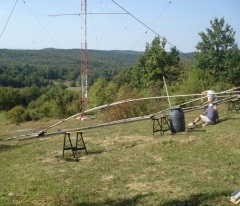 For 160m we use slopers (NE and NW), for 80m we use phased verticals with east-west switching. On 40 m we have several full size Yagi antenna systems for NE and NW direction.
Our receiving system (made by 9A6A) uses same 5 beverages for 160m, 80m and 40m band.
For 160m we use slopers (NE and NW), for 80m we use phased verticals with east-west switching. On 40 m we have several full size Yagi antenna systems for NE and NW direction.
Our receiving system (made by 9A6A) uses same 5 beverages for 160m, 80m and 40m band. For 20m, 15m and 10m we are using stack Yagi antenna system for NE and NW and for other directions we are using 3, 4, 6, 8 el Yagi depends of band.
We are using high power switching system for all bands, so we can be in a second in the right direction for a multiplier.
For each band we have home made (made by 9A6A) monoband linear amplifiers, so we don’t need to tune during the contest. The main equipments we are using in contests are TS950S, and FT100MP.
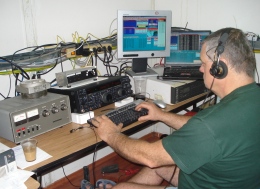 Towers, antenna system, receiving system, high power switches and even building we made alone. Hard work and lot of time we spend last few years to make 9A1A
one of the best signals in the world.
Towers, antenna system, receiving system, high power switches and even building we made alone. Hard work and lot of time we spend last few years to make 9A1A
one of the best signals in the world. In the last 20 years we have won in all the main contests. We were world champions in CQ WW SSB, CQ WW CW, in MM category, 1st place World Combined score 1992 CQ WW WPX, World champions in CQ WW 160m several times, world and European champions in CQ WW RTTY contest and CQ WPX RTTY contest.
We have no space on our wall for more ARRL plaques. We were world or European champions in nearly all ARRL CW and SSB contest in last 20 years. These results come from a small group of Croatian amateurs.
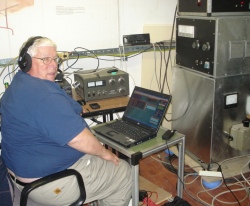 Many times we had an international group in some contests, including Dick Frey, K4XU, Carl Ikaheimo, OH6XY, Jackie Calvo, F2CW, who enjoyed visiting and working with us.
Bob Cox, K3EST, CQ WW contest manager, visited with us on his way home to Davis, California, from Friedrichshafen, Germany.
Many times we had an international group in some contests, including Dick Frey, K4XU, Carl Ikaheimo, OH6XY, Jackie Calvo, F2CW, who enjoyed visiting and working with us.
Bob Cox, K3EST, CQ WW contest manager, visited with us on his way home to Davis, California, from Friedrichshafen, Germany.Dick Ehrhorn, W4ETO, president of ETO and donor of the plaque for World Combined Score in the CQ WW Contest, came to present our plaque for the 1992 contest. Last year Dave, K1ZZ after his holiday in Croatia, visited our contest location. Charlie NF4A and Paul, N4PN worked with us many times in ARRL SSB contest.
Our members work in Croatian TV, hospitals, police, software production, etc, but we make a good group during the contest. Every week we have a meeting at the clubhouse to drink a beer and to make plans for next contest.
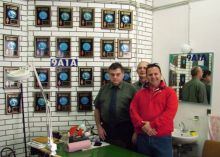 In Croatia, we now have about 2200 radio amateurs and many good contest groups, such as 9A7A, 9A5Y, 9A1P, 9A3B and others.
In Croatia, we now have about 2200 radio amateurs and many good contest groups, such as 9A7A, 9A5Y, 9A1P, 9A3B and others. This is information about our Croatian DX Club and Croatia, beautiful country with the most beautiful Adriatic coast, with more than 1100 islands (and 5 IOTA numbers EU-016, EU-090, EU-110, EU-136 and EU-170).
If you have questions about radio amateur activity in Croatia send me e-mail and I'll be happy to help you. See my web pages 9a6a.wordpress.com and qrz.com/db/9a6a and qrz.com/db/9a1a
D4C Monteverde Contest Team - Luca Aliprandi IK2NCJ
April 2014
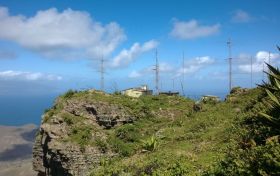 If you use to tune up the bands during main contest of the year you probably had the chance to copy and work “Delta four Charlie” callsign on all bands.
If you use to tune up the bands during main contest of the year you probably had the chance to copy and work “Delta four Charlie” callsign on all bands. This call is used to identify a team specifically born for contesting: The “Monteverde Contest Team” It is composed of six members, HB9DUR Andrea, I4UFH Fabio, I4YSS Vic, IK2NCJ Luca, IZ4DPV Max and YL2KL Girts and started the activity in November 2007 when D4C was on-the-air during CQWW DX CW as M/2.
The station is located on the Island of Sao Vicente, one of the ten islands that make up the archipelago of Cape Verde. Monteverde is the name of the mountain where the station has been established. more
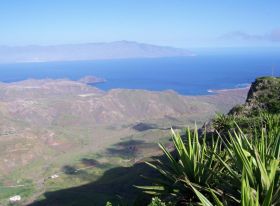 Monteverde is 2100 ft high positioned without any city building and this gave us the possibility of exploiting a very quiet place with very low “take-off” angles
in any direction.
Monteverde is 2100 ft high positioned without any city building and this gave us the possibility of exploiting a very quiet place with very low “take-off” angles
in any direction. Like all good things, even here there is a flip side, not very pleasant, due to a very high daily wind speed (around 35Mph) and high humidity that very often changes to a terrible fog. All this makes a very stressful environment for both humans and hardware.
The shack is 1200 square feet inside a property of about 86,000 square feet. The house has 2 bedrooms, 1 bathroom and a large open space where all 6 band positions can take space together with the kitchen.
Outside, 8 towers from 45 to 120 feet high are covering the entire area, that also includes a small garage that houses a 60KvA power generator.
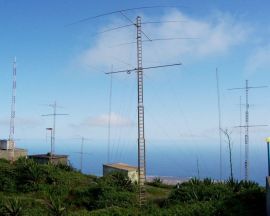 Because everything was erected from scratch, starting with D4B activity (the previous owner), we had the possibility to design a specific hardware according to
the location.
Because everything was erected from scratch, starting with D4B activity (the previous owner), we had the possibility to design a specific hardware according to
the location. The first thing we wished to eliminate was the rotators. It is easy to imagine how long they can resist in such an environment.
So we have all fixed antennas, 4 in each band from 10 to 20 (yagis) and 2 for 40 and 80m (2 el. delta loops). For top band we use a quarter wave vertical with 60 radials and we use a HI-Z 4 square + beverages for receive on the low bands.
To control all the hardware we don’t use any commercial devices. All the automatic switching system have been designed and built by ourselves. This includes a 6X4 antenna switch (antennas for 6 bands shared automatically between 4 positions), band-decoders and antenna switches.
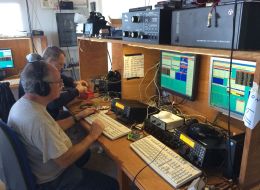 Underground we put about 1500 feet of ½” coaxial cable and about 300 feet of 7/8” coax plus several thousand feet of electrical cables for services.
Underground we put about 1500 feet of ½” coaxial cable and about 300 feet of 7/8” coax plus several thousand feet of electrical cables for services. About 5 tons of materials have been shipped from Europe from 2007 till now to allow us to turn into reality what was first designed on paper.
D4C has been active in all modes from 160 to 2m, collecting more than 250,000 qso’s.
On 6 meters we have a beacon running on 50.034 and very often it is spotted as the only signal on the band.
Due to our position this often happens also on 10m during contests.
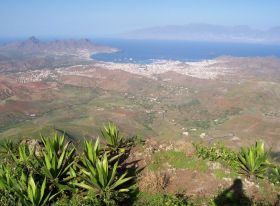 We are generally active in the Multi op categories, from M/S to M/2 but we started in CQWW CW 2012 to join M/M category and this has been replayed on 2013 both
SSB and CW. If you like to take a look at our scores please visit www.d4c.cc
We are generally active in the Multi op categories, from M/S to M/2 but we started in CQWW CW 2012 to join M/M category and this has been replayed on 2013 both
SSB and CW. If you like to take a look at our scores please visit www.d4c.cc Without the help of some people such a project would never have been possible. We must thank our technical partners:
Momobeam antennas (www.momobeam.com) for providing the antennas on our project.
Messi & Paoloni coax (www.messi.it) for supplying us with a double jacket coax cable to resist to hard humidity.
Coolqsl (www.coolqsl.com) to print our qsl cards.
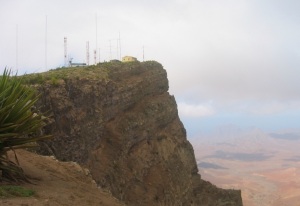 Thanks to the more than 30 guest operators that allow the team to reach top scores.
Thanks to the more than 30 guest operators that allow the team to reach top scores. Thanks to all of you that constantly call us during the contests.
We confirm qso's via LoTW, E-QSL and directly and bureau via manager IZ4DPV.
Our contacts:
Website: www.d4c.cc
Shop: http://shop.d4c.cc (support us!)
E-mail: info@d4c.cc
Facebook: www.facebook.com/D4C.STATION
Twitter: D4C_team
OL7M Contest Group - Pavel Prihoda OK1MU
February 2014
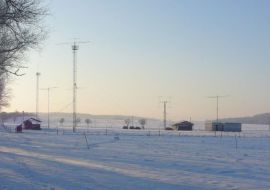 It was in May 2005 when our dream came true and we have bought 19,000 square meters (4.7 acres) of bare field. We began to build our HF QTH with 13 members of the OL7M team:
OK1CU, OK1CW, OK1CDJ, OK1DF, OK1FRE OK1HRA, OK1MU, OK1TYM, OK1UGA, OK1UOW, OK1XUB, OK1YM and OK2ZAW.
It was in May 2005 when our dream came true and we have bought 19,000 square meters (4.7 acres) of bare field. We began to build our HF QTH with 13 members of the OL7M team:
OK1CU, OK1CW, OK1CDJ, OK1DF, OK1FRE OK1HRA, OK1MU, OK1TYM, OK1UGA, OK1UOW, OK1XUB, OK1YM and OK2ZAW.We are active on all bands, starting on our favorite band 1.8MHz and ending on 10GHz microwave band. There is our QTH in the foothills of Orlické hory (Eagle mountains) about 80 miles east of the capital city Prague, in locator JO80cf.
There are three HF small houses with two-band shacks in each of them and one small separate house equipped for VHF-UHF EME operation. In addition there are two other houses used for accommodation and living. more
We have got eight towers nowadays and we hope to build two others for 10m and 40m soon.
Thanks to design and work of Dan OK1HRA and our main technical guru Jan OK2ZAW (http://remoteqth.com/) all HF Yagies, antenna switches, stack matches, rotator control servers and workplace controllers are home made.
We participate in all big contests in all modes during the year: CQWW, CQ WPX, ARRL, CQWW 160, IOTA, ARRL Roundup, OK-OM DX, OK DX RTTY. We are also regular members of the OK team in HQ IARU contest.
We broke the border of 100,000 contest QSOs during the ARRL Roundup 2014 contest.
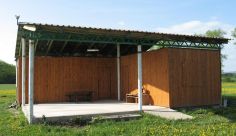 |
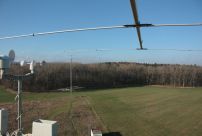 |
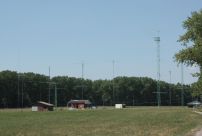 |
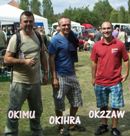 |
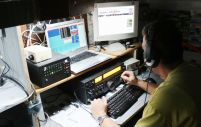
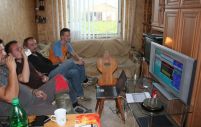 More pictures can be found on http://hamqth.com/ol7m
More pictures can be found on http://hamqth.com/ol7m For us, the amateurs in the heart of Europe, each QSO with W6/7 stations is an exhilarating experience. Thank you very much for that and we hope to hear you soon again!
73! Pavel OK1MU
On behalf of the OL7M team. close
Radio Amateur Association of West Greece SZ1A - Kostas Stamatis SV1DPI
January 2014
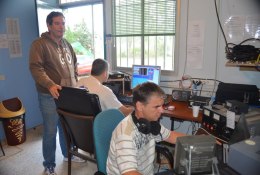 The Radio Amateur Association of West Greece (RAAWG) was founded in 1985. Our official call is SZ1A (ex. SV1AFA). The main population center, where the most of
our members are, is Agrinio, a town with a population of about 100,000.
The Radio Amateur Association of West Greece (RAAWG) was founded in 1985. Our official call is SZ1A (ex. SV1AFA). The main population center, where the most of
our members are, is Agrinio, a town with a population of about 100,000.Our original goal was not contesting but to join all amateurs in West Greece, to put some repeaters in nearby mountains, to organize courses for candidate hams, to educate them and to offer as volunteers to our community.
As a result, today we have to maintain three voice repeaters, four APRS digipeaters and one hf station (in our office in Agrinio) plus the Contest Station SZ1A in Red Forest. Our club numbers about 100 members at the present time. more
From the first days some of our members were very active in contests. In 1993 we participated in our first CQ WW SSB as a club in the M/S category using the call SV1AFA. We were first SV and this gave us a lot of pleasure!! This first participation created a tradition. So our club became the most active club in Greece in several HF contests.
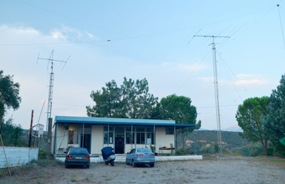 Our dream was to create a contest station. In Greece, most of us live in small condos and small properties in general. Just a very few Greek radio amateurs have the
space for big antennas and towers. There are many clubs that have a small HF station, a big station (by Greek standards) was an unfulfilled dream.
Our dream was to create a contest station. In Greece, most of us live in small condos and small properties in general. Just a very few Greek radio amateurs have the
space for big antennas and towers. There are many clubs that have a small HF station, a big station (by Greek standards) was an unfulfilled dream. This dream started to be a reality for us, in 2009. Then we found the place to host us, an old abandoned school in a place called Red Forest about 20 km out of Agrinio. We started to repair the building and in 2010 we raised our first tower 17m (55 ft) high. Our first contest from Red Forest was some months later, the ARRL CW in 2011.
We can host for free 5 operators at this moment in the station. There are beds, complete kitchen, bathroom.
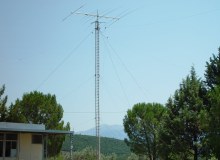 With a lot of offers from our members we have right now two stations working together:
With a lot of offers from our members we have right now two stations working together:First station: Icom 756 pro II – Icom PW1 a mplifier
Second station: Kenwood 850 sat – ZZ1600 amplifier
Dunestar band pass filters.
Antennas: Cushcraft X7, HyGain Exp14, dipoles for 80 and 160m, 3el wire beam for 40m to JA, Cushcraft 40-2cd (not installed yet)
Two towers, one 17m (55ft) and one 15m (45ft). One more tower about 12m, on the ground at the moment and waits to grow up (hi hi).
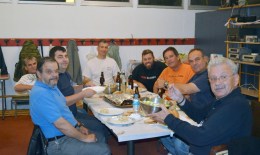 Unfortunately the SV bureau doesn't serve clubs anymore so we cannot receive your QSL card via the bureau. We upload to LotW after every contest and of course reply
to direct requests the same day. We also accept OQRS for Bureau cards. When we gather some requests, we mail direct to foreign bureaus. For OQRS,
please visit http://sz1a.org/index.php/links-2
Unfortunately the SV bureau doesn't serve clubs anymore so we cannot receive your QSL card via the bureau. We upload to LotW after every contest and of course reply
to direct requests the same day. We also accept OQRS for Bureau cards. When we gather some requests, we mail direct to foreign bureaus. For OQRS,
please visit http://sz1a.org/index.php/links-2Everyone, Greek or foreign amateur is welcome to come to Agrinio, visit us and operate the SZ1A station. If you need any help about SZ1A, please send an email to sz1a@qsl.net
Many photos from our activities can be found at picasaweb
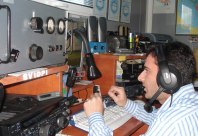 |
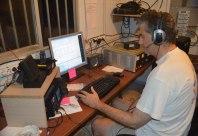 |
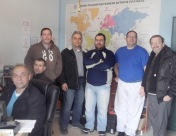 |
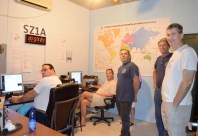 |
MW5A: Three A's Contest Group (G0AAA) - Steve Cole GW4BLE
January 2014
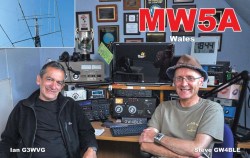 M5A is the contest call of the Three A's Contest Group G0AAA. The group was originally founded by G3TXF, G3SXW and G3WVG who got together to operate in RSGB Field Days
back in the 80s.
M5A is the contest call of the Three A's Contest Group G0AAA. The group was originally founded by G3TXF, G3SXW and G3WVG who got together to operate in RSGB Field Days
back in the 80s.The call MW5A was first operated [Single-Op All-Band] during CQWW CW 2002 by Ian G3WVG from my station located in Newport, Wales.
In CQWW CW 2002 Ian G3WVG made over 4,100 QSOs as MW5A [final score of 4.6m points] and in 2003 4,151 QSOs were made with a claimed score of 5.1m points, MW5A was also operated by G3WVG from here in CQWW CW [SOAB] in 2004 and 2005. more
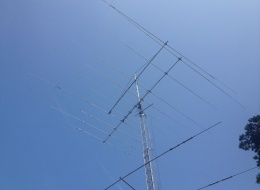 The most recent MW5A operation was in the 2012 ARRL 10m contest, prior to that the CQ-WPX-SSB in March 2011, single band 40 metres.
Contest audio is available here so if you made a QSO with MW5A
search against your call and hear how your signal sounded here in Wales.
The most recent MW5A operation was in the 2012 ARRL 10m contest, prior to that the CQ-WPX-SSB in March 2011, single band 40 metres.
Contest audio is available here so if you made a QSO with MW5A
search against your call and hear how your signal sounded here in Wales.In fact audio from just about all contests made in the last ten years under my own call (GW4BLE), MW5A or GW7X (contest call for Contest Cambria) is available here
Do a search against your own, or any other call, see the opening page for instructions. Random photographs of the GW4BLE station are generated each time the web site is accessed; there are over 100 in total, featuring the guest ops, station visitors, equipment etc... a kind of time line of the last thirty years at this QTH.
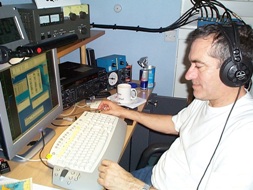 The station here is setup for SO2R with 2 x FTDX5000MPs, Alpha 78 and Drake L7 amp, with
microham MK2R+ controller. Outside there’s a TH11 stacked with a 402-CD
plus an 80m dipole high up in a neighbouring tree. There's also a Butternut HF9V vertical (handy to 'fill-in' when SO2R).
The station here is setup for SO2R with 2 x FTDX5000MPs, Alpha 78 and Drake L7 amp, with
microham MK2R+ controller. Outside there’s a TH11 stacked with a 402-CD
plus an 80m dipole high up in a neighbouring tree. There's also a Butternut HF9V vertical (handy to 'fill-in' when SO2R).QSLs for MW5A can be sent to the RSGB QSL Bureau. Direct QSLs for MW5A can be mailed to Nigel G3TXF. The most recent QSLing statistics can be found here
The call GW7X is also aired from the GW4BLE station, most recently in the ARRL 10m contest with G8DX, GWØARK, GWØRYT and GW4BLE. Conditions were excellent throughout the contest, although at times the echoes on some EU signals made them difficult to copy. GWØRYT had a great NA run on Saturday. more info close
The TM0R Contest Station - Jean Louis Zabalza F5GGL
January 2014
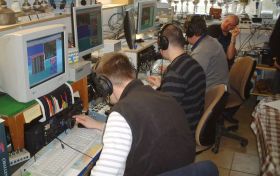 At the creation of the radio club in 1981, all members were all employees of La Poste and France Télécom housed in France Télécom premises. We opened membership to our
friends outside these companies, still with a quota to respect. We participated in a lot of Field Day activities, for which the infrastructure had to be carried.
At the creation of the radio club in 1981, all members were all employees of La Poste and France Télécom housed in France Télécom premises. We opened membership to our
friends outside these companies, still with a quota to respect. We participated in a lot of Field Day activities, for which the infrastructure had to be carried.Following the changes in management of the company that hosted us, we had to move three times to finally find a location 25 Km east of BORDEAUX, at locator IN94UT.
TM0R is the special call used by the F6KNB radio-club members. F6KNB belongs to the RADIOAMPT Association (La Poste and Orange staff) associated with the REF. Other friends are part of the amateur radio club too. more
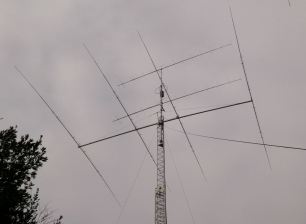 |
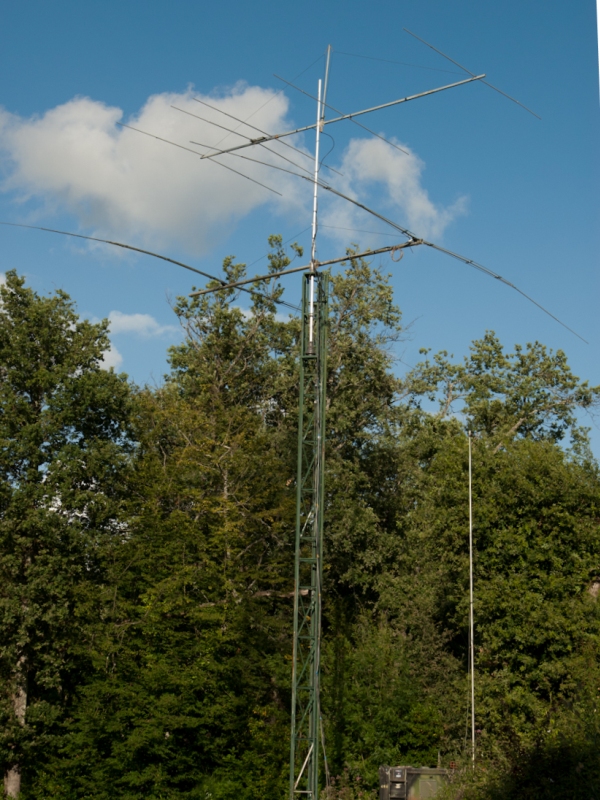 |
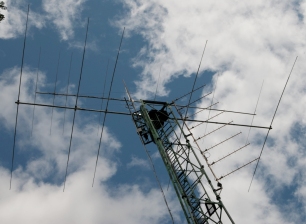 |
| 4 el 40m + 2x 11 el 2m | 2 el 40m + 5 el 15m | 5 el 20m + 7 el 10m |
|---|
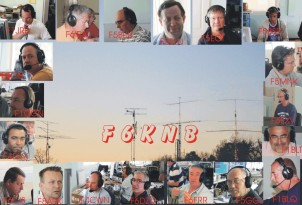 Our interest in the practice of radio, in addition to technical aspects, resides in participating in national or international contests.
Our interest in the practice of radio, in addition to technical aspects, resides in participating in national or international contests.The atmosphere between OM / YL is like in a family, everyone works so that our station can run smoothly. In between contests, everyone works on maintenance of RX and TX antennas, beams, wires, beverages which winds and bad weather occasionally tear down.
Equipment modernization and updating software is also part of the work required for the operation of a station worth to compete for the top scores.
What a pleasure to contact California ... Hi ... The Pacific Islands and all those distant regions far from France...
Each operator is trying to improve and progress in his operating skills, participating in major international competitions. (CQ WW SSB and CW, SSB and CW WPX, ARRL DX SSB and CW, RUSSIAN DX CONTEST, etc ...).
See you on the air 73s - Jean Louis Zabalza F5GGL less
The East Coast Contesters: ZM4T - Lee Jennings ZL2AL
January 2014
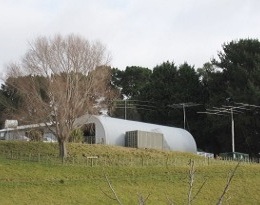 I was born in Toronto and grew up there, becoming a ham in 1953. In 1969 I decided to settle in New Zealand. Living in Hawkes Bay for the past 37 years has allowed
me to erect antennas, build a good station and work a lot of DX. New Zealand is a great place to operate radio from.
I was born in Toronto and grew up there, becoming a ham in 1953. In 1969 I decided to settle in New Zealand. Living in Hawkes Bay for the past 37 years has allowed
me to erect antennas, build a good station and work a lot of DX. New Zealand is a great place to operate radio from.In 2006 I decided to get serious about contesting and set up a competitive New Zealand contest team to do the Oceania and CQWW contests. A local farmer had a magnificent site about 20 miles north of Napier about a mile in from the Pacific and on a 300 foot hill with sweeping views into all parts of the world.
For approximately 180 degrees, the horizon is the Pacific Ocean looking East towards the Americas. He agreed to allow us to set up a permanent antenna farm and use his shed to operate from on the weekends. more
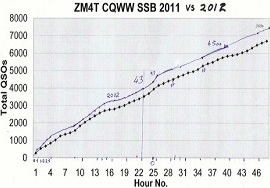 The ZM4T East Coast Contesters Team was born in 2006. We usually plan on contesting the Oceania, CQ WPX and the CQWW contests each year. Both CW and SSB modes are used.
The ZM4T East Coast Contesters Team was born in 2006. We usually plan on contesting the Oceania, CQ WPX and the CQWW contests each year. Both CW and SSB modes are used.Entries in the Multi – Single, Multi- Two and Multi – multi are decided upon depending on operator availability. Our scores have increased yearly, our equipment and skills keep improving and the team has grown to 10 members.
We often have quality guest operators from other parts of ZL who want to join us for the weekend. We usually rank #1 or #2 in ZL and Oceania for each contest. A contesting team is a fantastic way to bond with other hams and achieve lasting friendships while improving operating skills. You can see the team in action at www.zm4t.com
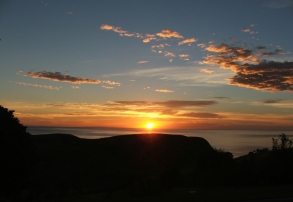 Operating a contest from Zl is interesting as we are so far from the rest of the world. Pointing Yagis NE gives us all of the Pacific and NA. Moving the antennas
to NW gives us EUs and most of Asia. A ZL (ZM) call is rare and we are highly sought after as Zone 32. When the bands are open we can easily generate huge pileups.
Operating a contest from Zl is interesting as we are so far from the rest of the world. Pointing Yagis NE gives us all of the Pacific and NA. Moving the antennas
to NW gives us EUs and most of Asia. A ZL (ZM) call is rare and we are highly sought after as Zone 32. When the bands are open we can easily generate huge pileups.The downside of competing from ZL is the location itself. We are 42 degrees below the equator and Africa is not easy. With most of the big contest stations on the equator, NA or in EU it is often a struggle on 40 and 80 metres to crack the walls.
In 2009, we set a ZL Record in the CQWW SSB Multi two category. We did it again in 2010 and managed to better the ZL record again in 2012 and also came 1st in Oceania. 2013 has been a great year for the team setting new records again in the Oceania Contests and the CQWW contests in both CW and SSB modes.
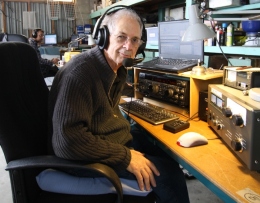 The reason we keep improving is constantly fine tuning antennas and equipment along with better strategy planning before each contest. We know what works for each
contest and the a team debriefing after each contest brings out new ideas to improve our performance the next time around.
The reason we keep improving is constantly fine tuning antennas and equipment along with better strategy planning before each contest. We know what works for each
contest and the a team debriefing after each contest brings out new ideas to improve our performance the next time around.Our goal from the beginning is to have a fun weekends each contest and improve our operating skills. We have achieved that and more over the years and the the East Coast Contesters ZM4T team are looking forward to the next contest year in 2014.
The operators are: Lee ZL2AL, Stan ZL2ST, Gary ZL2IFB, Mike ZL2CC, Michael ZL2MY, Holger ZL3IO, Wayne ZL2WG, Peter ZL2LF, John ZL1BYZ
73, Lee ZL2AL less
LZ9W M/M Contest Station - Wally LZ2CJ
December 2013
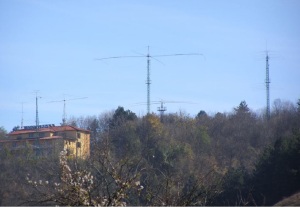 The station is located at the hotel Bardoto, right on top of a very steep 900m asl high rock, just outside the small town of Breznik,
about 60 km from the Bulgarian capital Sofia. It is owned by Krassimir Pavlov LZ1ZD.
The station is located at the hotel Bardoto, right on top of a very steep 900m asl high rock, just outside the small town of Breznik,
about 60 km from the Bulgarian capital Sofia. It is owned by Krassimir Pavlov LZ1ZD.Activity of LZ9W as a M/M contest station started with the WPX SSB contest in 2003 when we placed 2nd in Europe. This was followed by participation in WPX CW 2003 in which we placed No1. Europe and 2nd World!
Through the years we have won No.1 World M/M twice in the WPX CW contest. A full list of our scores and more information about LZ9W can be found on our web site www.lz9w.com. In 2013 we celebrated our 10 years anniversary! more
The current core group of operators is: LZ1ZD, LZ1PM, LZ1UQ, LZ1FG, LZ1ANA, LZ2CJ, LZ2HQ, LZ2PO, LZ2UU, LZ3FM, LZ3UM
Visiting operators: LZ1PJ, LZ2UX, LZ2FV, LZ2WO, LZ3SM, LZ1GL and others.
LZ2GL and LZ3UM are taking care for all hardware and LZ3FM is our computer man. LZ2HQ and LZ1PM are our main antenna men, they are brave guys who climb all these towers. LZ3UM and LZ1ANA have also done a lot of work doing antenna installation.
Antennas on 160m are Inverted Vee at 40m, top loaded vertical and several Beverages. The rest of the antenna farm is shown below.
See you all in next contest.
73, Wally LZ2CJ on behalf of LZ9W M/M Contest Team
JT5DX Contesting From Mongolia - Chak Choigonjav JT1CO
December 2013
 Our contest station JT5DX is located 370km northwest of Ulaanbaatar capatal city of Mongolia. It is 15km away from the Russian border. It takes about 5-6 hour using
public transportation and 3-4 hours with car to get to JT5DX contest station from Ulaanbaatar.
Our contest station JT5DX is located 370km northwest of Ulaanbaatar capatal city of Mongolia. It is 15km away from the Russian border. It takes about 5-6 hour using
public transportation and 3-4 hours with car to get to JT5DX contest station from Ulaanbaatar.It is located in my company “Arvin Khur”. Arvin Khur is an Agricultural company located at JT5. The company mainly plants wheat and Canola and also sell products such as Cold pressed Canola Oil, Natural Honey etc.
It is about 20-35 degree celsius in the Summer and -15- -35 degree celsius in the winter. During fall there are many mosquitoes. It is also very close to the Selenge river. more

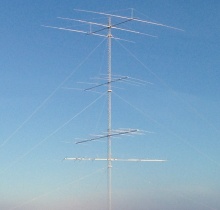 At the JT5DX contest station there are 2 Rotating Rohn45 towers 40m height and 2 fixed 43m tall towers with 40m 3 ele yagi x2, 20m 5 ele yagi x2, 10m 7 ele yagi, 15m 7 ele yagi
and monster 160 m 4sq 80m 4sq as antennas.
At the JT5DX contest station there are 2 Rotating Rohn45 towers 40m height and 2 fixed 43m tall towers with 40m 3 ele yagi x2, 20m 5 ele yagi x2, 10m 7 ele yagi, 15m 7 ele yagi
and monster 160 m 4sq 80m 4sq as antennas.My rig Elecraft K3, IC7800, FT2000, FT1000MP, FT100, ACOM 2000, TOKYO HY POWER 3.5k, ALPHA 87A, PV.
With this equipment it is possible to work with multi-multi Multi2 and Multi single during contests. Contesting from here it is very comfortable with warm housings, full plumbing, warm water and everything you would expect from comfortable and enjoyable contest station.
It is comfortable in all seasons because of the buildings and there are no problems regarding weather. Also we have accommodations available for contesters to rest and take a shower.
 It took almost 4 years for the contest station to be fully operational and we may choose to add more things to the contesting station in the future.
It took almost 4 years for the contest station to be fully operational and we may choose to add more things to the contesting station in the future.I have had many great contesting experiences at my contest station and also many great achievements. Many of my contesting informations are available on the internet, you may search for JT5DX to see clear examples of how amazing the contest station functions.
We also have had many operators to our station as guests such as YT1AD Hrane, K1LZ Krassy, K4ZW....... We are now planning to put together a contest group with member from all around the world that are willing to come and work from Mongolia.
We may rent the contest station, as we are currently not sure about that we are still interested in contesting ourselves for the next few years. We may rent the contest station during regular periods if people are interested in working from Mongolia. less
Radio Klub Varaždin 9A7A Contest Station - Sam Puzak 9A3OS
December 2013
 Before we say something about contesting at 9A7A it would be worth mentioning that contesting from our radio club has a rich history.
Before we say something about contesting at 9A7A it would be worth mentioning that contesting from our radio club has a rich history.Serious contesting started around the 1970's when amateur radio popularity started rapidly increasing. During that period we used our ex Yugoslav calls, YU2HDE on HF and YU2CBE on VHF, we also had a special contest call 4N2V.
In 1991 Croatia became independent. YU2HDE became 9A1HDE and we issued a request for a special contest call: 9A7A. more
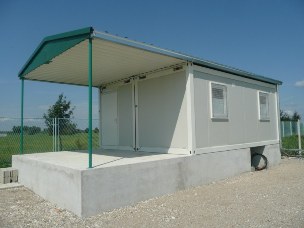 In 1991. we were lucky to get possesion of an abandoned radio station which was used for local radio broadcasting on 160m. The station was located some 3km
south from the city of Varazdin. We used that station in contesting for almost 18 years (1991-2009). Unfortunately, we had to leave this location at the end of 2009,
because we where not the owners.
In 1991. we were lucky to get possesion of an abandoned radio station which was used for local radio broadcasting on 160m. The station was located some 3km
south from the city of Varazdin. We used that station in contesting for almost 18 years (1991-2009). Unfortunately, we had to leave this location at the end of 2009,
because we where not the owners.Our current contest location is 2km north of the city of Varazdin. It is a parcel of 100x50m on which the container we use for a radio shack and the antennas are located. When we came here, we found a plain field, therefore we had to build the contest station from scratch. A number of people spent hours and hours to bring things to the level we had before. The contest station is in the constant process of growing. We participate in all major world contests, ie. WW, WPX, RDXC, ARRL, both, CW and SSB, mostly M/S or M/2 category.

The radio shack consists of:
- 2x TS-590
- FT-2000
- TS-2000
- TL-922
- Drake L-7
- OM-2000
- Other home made amps.
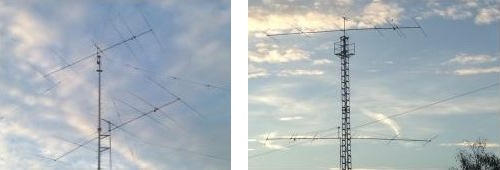 The erected towers range in height between 10m and 25m. The antenna setup consists of:
The erected towers range in height between 10m and 25m. The antenna setup consists of:
- 160M T-vertical
- 80M Vertical, dipole
- 40M 4el KLM
- 20m 6el G0KSC OWA yagi
- 15m 6/6 G0KSC OWA yagi stack
- 10m 7/7 G0KSC OWA yagi stack
- 7 el triband used as in-band antenna
 There were a number of people operated from our contest station in the past, but the current operators are:
There were a number of people operated from our contest station in the past, but the current operators are:
- 9A3TR
- 9A3OS
- 9A5BWW
- 9A5X
- 9A6NA
- 9A6NDH
- 9A7V
- 9A5F
- 9A4BT
Contesting from Rarotonga - N6NB and W6TAI
November 2013
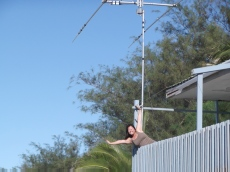 N6NB (Wayne) and W6TAI (Carrie) operated from Rarotonga in the South Cook Islands for two contests in 2012.
We stayed at the same motel where the E51Z group operated CQ WW phone in 2011 and benefited greatly from their experience on the island.
On the first trip, Wayne operated the ARRL International DX Contest SSB as E51YNB in the single operator, single band (15m) category while Carrie concentrated
on hiking across the island and biking its perimeter. Operation was limited to 11 hours in order to catch the weekly flight from Rarotonga to the United States
which departs on Saturday nights.
N6NB (Wayne) and W6TAI (Carrie) operated from Rarotonga in the South Cook Islands for two contests in 2012.
We stayed at the same motel where the E51Z group operated CQ WW phone in 2011 and benefited greatly from their experience on the island.
On the first trip, Wayne operated the ARRL International DX Contest SSB as E51YNB in the single operator, single band (15m) category while Carrie concentrated
on hiking across the island and biking its perimeter. Operation was limited to 11 hours in order to catch the weekly flight from Rarotonga to the United States
which departs on Saturday nights.The station consisted of an IC-7000, a small THP amplifier and a two element Yagi on a mast mounted on the motel's second story balcony. It was a home made single band (15m) yagi that was broken into short pieces to fit in a 30 inch rolling duffel bag. more
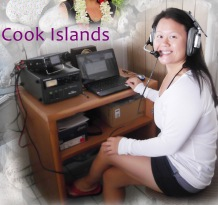 On the second trip, Carrie operated SSB only in the 2012 IARU HF World Championship ("IARU Radiosport") as E51TAI in the single operator high power (unassisted)
category. For this contest the station was the same but the antenna was a TH-2 tribander and a 16ft mast with a TV-type antenna rotator that had been shipped
out in advance and stored by E51CG. Victor and his wife Eleanor extended us wonderful hospitality.
On the second trip, Carrie operated SSB only in the 2012 IARU HF World Championship ("IARU Radiosport") as E51TAI in the single operator high power (unassisted)
category. For this contest the station was the same but the antenna was a TH-2 tribander and a 16ft mast with a TV-type antenna rotator that had been shipped
out in advance and stored by E51CG. Victor and his wife Eleanor extended us wonderful hospitality.For N6NB, it was a first-ever overseas HF DXpedition after 55 years on the air. For W6TAI, it was a first experience as a single operator in a DX contest. We were both astonished by what we heard during the contests, there were huge pile-ups. For N6NB, it was all North American stations because only W/VE contacts count during the ARRL DX test. For W6TAI, it was a worldwide contesting experience, limited only by the effects of a solar flare that curtailed propagation (especially to Europe) during IARU. Thanks to everyone for being patient with us. Some waited 30 minutes or more to get through as we struggled to sort out the strong signals.
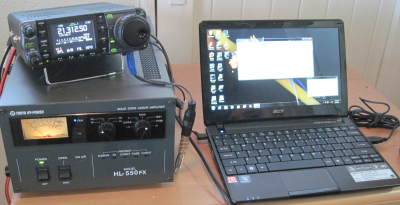 Stations all across North America and Asia were loud on one band or another all day long and much of the night. The suitcase station seemed to work really well
and conditions were generally good (in spite of the solar flare that hit during IARU). We each made over 1,400 contest contacts despite limited operating time.
Stations all across North America and Asia were loud on one band or another all day long and much of the night. The suitcase station seemed to work really well
and conditions were generally good (in spite of the solar flare that hit during IARU). We each made over 1,400 contest contacts despite limited operating time.A surprising number of those contacts turned out to be with people using less than five watts or low-profile antennas in communities where outdoor antennas are prohibited. Probably a more experienced DX contest operator could have made far more contacts than we did in the same amount of time, but it was a memorable experience for both of us.
If you have a good signal from there, you will acquire a pile-up within 60-90 seconds. You will be spotted that quickly. It is a favorite destination for DXpeditions because there is a non stop flight from Los Angeles plus a motel with a prime radio location. Put up a modest antenna there, run 500 watts and you are guaranteed a big signal. The video and audio clips I have heard are amazing. less
OM7M Low Bands Contest Club - Lubo Martiska OM5ZW
December 2013
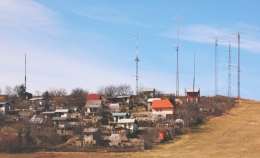 The radio club was founded after the Second World War in 1949 former Czechoslovakia. It consisted of a group of enthusiastic guys dealing with construction of HF radios
and working on the VHF/UHF bands.
The radio club was founded after the Second World War in 1949 former Czechoslovakia. It consisted of a group of enthusiastic guys dealing with construction of HF radios
and working on the VHF/UHF bands.Gradually the radio club erected HF beams (2el Cubical Quad, dipoles for low bands…) and the HF radio was an FTDX 505 (150W). The club was situated in the center of the historical town of Partizanske.
The main source of interest was HF and VHF operation, especially on 20 and 40m. We took part in all major local and WW HF and VHF contests. more
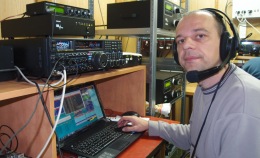 Increased industrial QRM in the town and a huge expansion of TVI and BCI in 1989 resulted in our moving to the nearest village 2 km away from Partizanske (an area of garden allotments - no TVs).
We started immediately building low band antennas (hence the name "Low Bands Contest Club"). We built a 27m vertical for top band and 2x Bobtail Curtains for 80/75m.
Increased industrial QRM in the town and a huge expansion of TVI and BCI in 1989 resulted in our moving to the nearest village 2 km away from Partizanske (an area of garden allotments - no TVs).
We started immediately building low band antennas (hence the name "Low Bands Contest Club"). We built a 27m vertical for top band and 2x Bobtail Curtains for 80/75m.A year later we erected the first antenna mast for 20, 15 and 10. The complete antenna system was finished in 1991. In 1993 we changed our call sign to OM3KAP after Czechoslovakia split off. In the early 90’s we used TRX IC 751A and a home-made power amplifier. The only missing antenna was 40m where we used to use a vertical or loop antenna.
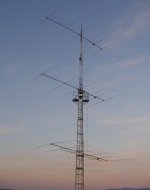 By and by we started to build other antenna masts. First stack that we built was 2x6el on 20m (32m/20m). Then we added 3x6el. on 15m (27/18/9m) and 4el. HB9CV on
40m (35m up, this antenna is really “big gun”). In the beginning we phased it with a 2 el. HB9CV but gradually we found out that it didn’t pay off.
By and by we started to build other antenna masts. First stack that we built was 2x6el on 20m (32m/20m). Then we added 3x6el. on 15m (27/18/9m) and 4el. HB9CV on
40m (35m up, this antenna is really “big gun”). In the beginning we phased it with a 2 el. HB9CV but gradually we found out that it didn’t pay off.Another tower 35m is mainly intended for 10m. We have a stack of 3x6el. OWA Yagi’s on that mast. On this mast we have free slots for another 2 antennas in phase. The last tower that we’ve finished is 30m high for sub direction beaming. It’s equipped with a Mosley TA53M and a former HB9CV on 40m.
During winter we usually use beverage antennas up to 6-7 directions (max length wire is 258m). In summary we have the following antennas: 160m Half Sloper, 80m 2xHalf Square, Dipole, 40m 4el. HB9CV, 2el HB9CV, 20m 2x6el. OWA Yagi, TA53M, 15m 3x6el. OWA Yagi, TA53M, 10m 3x6el. OWA Yagi, TA53M, Beverages for RX on low bands.
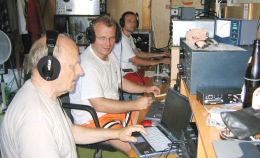 We take part in all the major HF contests (CQ WW, CQ WPX, ARRL DX, IARU, CQ 160).
We take part in all the major HF contests (CQ WW, CQ WPX, ARRL DX, IARU, CQ 160).We have a couple of very experienced operators (OM3PA, OM3PC, OM3FW, OM4MM, OM5AA, OM5MF, OM5NU,OM5RW, OM5RM, OM5ZW) and guests (it depends who is currently available). The contest leader is Lubo, OM5ZW who has been on the air more than 30 years (he started with ham radio as a small boy).
We prefer CW contests because most of our team are former high speed telegraphy champions. Another part of our team is mechanical and electrical designers and constructers (OM5BP,OM3CHR).
We have tried all Multi categories (M/S, M/M, M/2) and our biggest success is European victories in CQWW in M/S and CQ WPX in M/2 and the ARRL DX contest. Our favourite contest is also CQ 160m where we have achieved top WW/EU ranking. More information about our operation is on the web site www.om7m.org
 |
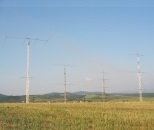 |
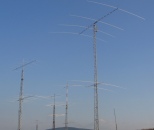 |
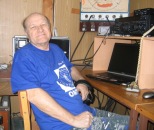 |
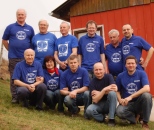 |
